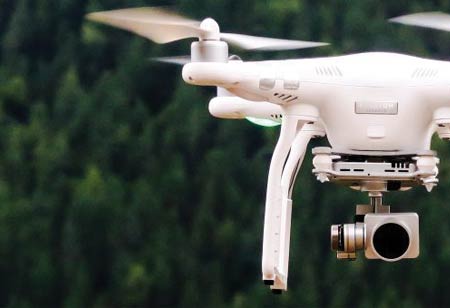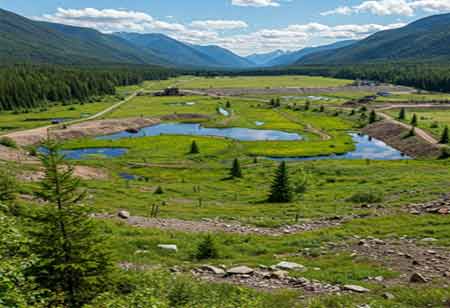Thank you for Subscribing to Environmental Business Review Weekly Brief
Europe's Green Guardians: Advanced Technologies in Forest Conservation
Advanced technologies like AI, drones, and sensors enhance forest conservation through real-time monitoring and predictive analytics, promoting community involvement for effective ecosystem protection.

By
Environmental Business Review | Friday, June 20, 2025
Stay ahead of the industry with exclusive feature stories on the top companies, expert insights and the latest news delivered straight to your inbox. Subscribe today.
Forests represent some of the most essential ecosystems on the planet, functioning as carbon sinks, biodiversity reservoirs, and natural climate regulators. However, these critical environments face significant threats from illegal logging, wildfires, habitat destruction, and the consequences of climate change. The imperative for a comprehensive forest protection system has never been more pressing.
In response, European scientists, technologists, environmentalists, and governmental entities collaborate to develop and implement advanced solutions to preserve forested landscapes for future generations. These initiatives integrate established conservation principles with modern technologies that facilitate real-time detection, assessment, mitigation, and management of threats to forest ecosystems.
Intelligent Monitoring Through Integrated Technologies
One of the most potent trends in modern forest protection is the ability to monitor vast land areas with unprecedented accuracy and speed. Advanced sensor networks, drones, satellites, and artificial intelligence all work together to give real-time information on forest conditions. These technologies notice changes in vegetation, differential temperature measurements, alterations in soil moisture content, and indications of unauthorized human activity.
Satellites, allowing remote sensing through civilian imagery, are tracking continents for deforestation trends and land use change. The learned patterns and anomalies in the processed satellite data are strong indicators of illegal activities or real risks such as insect infestations and drought stress. Very high-resolution drones equipped with cameras and thermal sensors will fly over the forest canopies, gaining imagery and video from otherwise inaccessible or dangerous areas for human surveillance. These images assist in identifying tree health, fire hotspots, and illegal encampments.
Ground-based sensors embedded in the forest collect environmental information and send it into a centralized system for analysis. These sensors measure humidity, temperature, and sound signatures that may signal early occurrences of fire or logging. Altogether, this technology provides a dense and intelligent surveillance network, covering large and otherwise inaccessible forest areas much better than any manual patrol method.
AI and Predictive Analytics for Proactive Protection
The other significant activity where AI accelerates the move from a reactive to a proactive paradigm in forest protection is anticipating threats and advising preemptive strategies by examining historical and real-time datasets. For instance, predictive models can relate weather, type of vegetation, and human activities to identify areas with a high probability of wildfire. Forest managers can focus on preparing firebreaks, alerting communities, or undertaking controlled burns to reduce fuels in response to these forewarnings.
Likewise, machine learning algorithms are being developed to recognize and differentiate between natural and anthropogenic sounds in forest environments. These technologies help promptly trigger alerts for illegal chainsawing or vehicle movement in restricted areas, thus shortening forest rangers' response time, who now have better chances of catching the infractors before severe damage occurs.
AI is also being used to optimize reforestation. By mapping the best areas to plant based on soil quality, water availability, and compatible species, restoration projects become much more efficient and ecologically viable. This interactive means of informed decision-making can keep any concerted effort to restore forests prosperous in the short term and resilient under the next set of challenges.
Community Participation and Decentralized Response Systems
While technology serves as a critical component of advanced forest protection systems, its success largely depends on the active involvement of local communities and the establishment of decentralized action frameworks. Indigenous peoples, residents, and individuals who rely on forests for their livelihoods possess profound knowledge of the land and its cyclical patterns. Integrating this local expertise into conservation strategies fosters a more holistic and culturally respectful approach to forest protection.
The advent of digital platforms and mobile applications has enabled communities to participate directly in conservation initiatives. Individuals can now report suspicious activities, share geotagged photographs, and receive alerts concerning nearby threats, thereby positioning themselves as invaluable partners in forest monitoring. This democratization of technology ensures that the responsibility for forest protection is not confined to central agencies but is shared among all stakeholders invested in forest preservation.
Implementing a decentralized response system grounded in sensor data and an artificial intelligence framework enhances the coordination of emergency efforts. In a forest fire, such a system can promptly alert nearby individuals, mobilize firefighting resources, and deploy drones to assess the fire's spread, ultimately minimizing damage and increasing the resilience of ecosystems and human settlements.
Given that threats to forests are expanding in scale and complexity, it has become evident that static and antiquated methodologies are inadequate for contemporary conservation efforts. An advanced forest protection system, guided by artificial intelligence, predictive analytics, and robust community engagement, must confront the multifaceted challenges that our forests face today. The sustainability of forest protection will come from innovative approaches to ecological stewardship aimed at safeguarding the world's forests and supporting all life on Earth.
More in News





